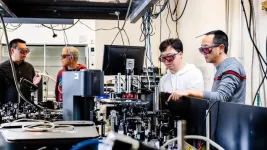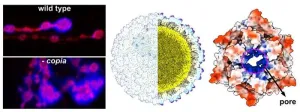(Press-News.org) A new study published in JAMA Network Open finds that low Medicaid telehealth reimbursement in New York State may be exacerbating a workforce crisis at Federally Qualified Health Centers (FQHCs), particularly among mental health care practitioners. The challenge compounds existing financial instability at FQHCs and barriers to telehealth access among low-income New Yorkers who rely on safety-net care.
The study, led by researchers at Columbia University Mailman School of Public Health, highlights several possible solutions, including payment parity for telehealth services, long-term funding for telehealth infrastructure, and support for hybrid care models to meet diverse patient needs.
“Telehealth has many advantages for patients and providers, but only if it’s supported by equitable and sustainable funding policies,” says first author Thalia Porteny, PhD, assistant professor of Health Policy and Management. “Our findings underscore the urgent need for Medicaid reimbursement reforms to address workforce shortages and ensure vulnerable populations can access the care they need.”
The researchers conducted 56 interviews with leadership, clinicians, and administrative staff at six FQHCs in all five boroughs of New York City. Participants described telehealth experiences, including factors related to staff turnover, patient satisfaction, and financial sustainability within FQHCs.
Key Findings:
FQHCs reported losing up to 40 percent of their mental health staff due to inadequate reimbursement and lack of remote work options, leading to long patient waitlists and reduced access to care.
Many patients face barriers to telehealth, including lack of internet access and digital literacy, particularly among older adults and those with limited English proficiency.
Current reimbursement policies create disparities between FQHCs and other providers such as hospitals, leaving FQHCs underfunded and unable to compete for staff or invest in telehealth infrastructure.
“In the face of potential Medicaid cuts and broader austerity measures, our study’s findings suggest that it would be detrimental to implement cost-cutting measures in telehealth reimbursements in community health centers in New York and more broadly,” says co-author Sorcha A. Brophy, PhD, assistant professor of Health Policy and Management. “Such budget cuts could exacerbate provider shortages, increase barriers to care for vulnerable populations, and ultimately lead to worse health outcomes. Consequently, this could further destabilize community health centers—a healthcare program that has long enjoyed bipartisan support.”
An accompanying editorial written by Isaac Dapkins of NYU Langone and NYU Grossman School of Medicine praises the study. Dapkins serves as Chief Medical Officer of a large FQHC in Brooklyn and chair of the clinical committee for the Community Health Center Association of New York. “Porteny et al have presented an outstanding summary of the impact of Medicaid telehealth reimbursement changes. FQHCs have been a core pillar of access to care in the US for years and are a model primary care service delivery,” he writes.
The study was co-authored by Emily Burroughs, a former Columbia Mailman research associate.
This study was funded through a Seed Grant Award from the Columbia Population Research Center, awarded to Brophy and Porteny.
END
Medicaid telehealth reimbursement policies are exacerbating workforce shortages in safety net clinics, study finds
2025-02-18
ELSE PRESS RELEASES FROM THIS DATE:
Texas McCombs faculty research hits historic high
2025-02-18
AUSTIN, Texas -- McCombs’ faculty research leaped 10 spots to No. 10 worldwide in the Financial Times’ release of its Global MBA Rankings for 2025, a historic high for McCombs reaching back to 1999.
The top spot for research went to the University of Pennsylvania, with Columbia University and the University of Chicago tying for second place.
Faculty Research is the third weightiest component (10%) of the 21 used in the MBA ranking, behind percentage of salary increase (16%) and salary three years post-graduation ...
Multiple sclerosis: Cell-catching implant helps identify successful treatment in mice
2025-02-18
Images
A sponge-like implant in mice helped guide a treatment that slowed or stopped a degenerative condition similar to multiple sclerosis in humans. It also gave University of Michigan researchers a first look at how primary progressive multiple sclerosis, the fastest-progressing version of the disease, attacks the central nervous system early on.
If administered early, the nanoparticle-based treatment prevented mice from developing symptoms such as paralysis. If given after the first symptoms emerged, it reduced symptom scores by half compared to untreated ...
Q&A: Is it always ‘us vs them’? Researcher explains why flexibility is key
2025-02-18
UNIVERSITY PARK , Pa. — Urban versus rural. Penn State versus Michigan. Star Wars versus Star Trek. As social beings, humans gravitate toward groups. But sometimes group living can spur an “us versus them” mentality that causes conflict, especially when two groups are competing for the same limited resources, like money or a championship trophy.
In the following Q&A, Anne Pisor, assistant professor of anthropology at Penn State and Social Science Research Institute co-funded faculty member, discussed her recently published paper on the “us versus them” mindset as well as the causes and how to overcome it.
Q: What does your research say about ...
New nanoscale technique unlocks quantum material secrets
2025-02-18
Scientists are racing to develop new materials for quantum technologies in computing and sensing for ultraprecise measurements. For these future technologies to transition from the laboratory to real-world applications, a much deeper understanding is needed of the behavior near surfaces, especially those at interfaces between materials.
Scientists at the U.S. Department of Energy’s (DOE) Argonne National Laboratory have unveiled a new technique that could help advance the development of quantum technology. Their innovation, surface-sensitive spintronic terahertz spectroscopy (SSTS), provides an unprecedented look at how quantum ...
New study uncovers how genes influence retinal aging and brain health
2025-02-18
Vision changes are an inevitable part of aging, but why are some more susceptible to age-related eye diseases and why do some individuals experience more severe decline than others? New research from The Jackson Laboratory (JAX) reveals that genetics play a key role in how the eye ages, with different genetic backgrounds influencing retinal aging in distinct ways.
The study, published in Molecular Neurodegeneration, examined age-related changes in genes and proteins of the retinas of nine strains of mice, ...
‘False’ springs, long summers mean uncertainty for NY grape growers
2025-02-18
CORNELL UNIVERSITY MEDIA RELATIONS OFFICE
FOR RELEASE: Feb. 17, 2025
Kaitlyn Serrao
607-882-1140
kms465@cornell.edu
‘False’ springs, long summers mean uncertainty for NY grape growers
ITHACA, N.Y. – Warmer autumns and more “false” springs are disrupting the signals grapevines rely on to gain cold hardiness for the winter and blossom effectively in the spring, according to new research from Cornell University.
“In New York, we are right at the coldest ...
A treatment-resistant, severe type of asthma successfully modeled in mice
2025-02-18
A better understanding of inflammation and lung immunity over the past two decades has led to new, innovative treatments for asthma, including biologic therapies.
This is especially true for a subtype known as eosinophilic asthma—asthma that’s related to the recruitment and overactivation of white blood cells in the lungs called eosinophils.
However, a different type of asthma called neutrophilic asthma has fewer treatment options and doesn’t respond as well to first line asthma therapy.
As a result, people with this type of asthma, which ...
Cholesterol metabolism byproduct linked to Parkinson’s disease
2025-02-18
Researchers led by Zhentao Zhang at Wuhan University, China have discovered a cholesterol metabolite that plays a critical role in the development of Parkinson’s disease in mice. Published in the open-access journal PLOS Biology on February 18th, the study shows that this metabolite is responsible for the formation of Lewy bodies and the death of dopaminergic neurons in the brain—the two major hallmarks of Parkinson’s disease. Blocking its activity or preventing it from being made by the body could therefore be effective strategies for treating the disease.
Parkinson’s disease develops when the protein alpha-Syn forms clumps of tiny pathological fibers ...
The capsid of the virus-derived retrotransposon Copia, a parasitic genome element, mediates synaptic plasticity at the Drosophila neuromuscular junction
2025-02-18
In your coverage, please use this URL to provide access to the freely available paper in PLOS Biology: https://plos.io/42Ly2Pr
Article title: Capsid transfer of the retrotransposon Copia controls structural synaptic plasticity in Drosophila
Author countries: United States
Funding: This work was supported by NIH Grant R01NS112492 to TT. The funders had no role in study design, data collection and analysis, decision to publish, or preparation of the manuscript. END ...
Sweet molasses feed key to understanding grazing behavior in cattle
2025-02-18
Researchers tempted grazing cattle with sweet molasses feed to discover whether cows would roam far and wide to graze or stick close to the herd, water supplies and feed stations.
The findings by animal scientists at the University of California, Davis, and published in the journal Scientific Reports, offer a low-cost way for ranchers and others to identify the best cows for their landscapes to optimize grazing while meeting the nutritional needs of cattle.
This is the third in a series of papers about research seeking to better understand the grazing personalities of cattle. The first studies ...




